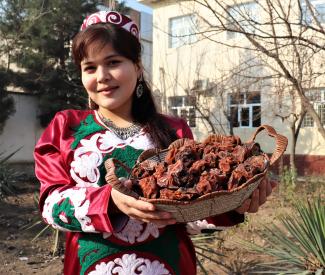Tajikistan is highly vulnerable to food insecurity where more than 27 percent of the population live on less than $1.90 per day. Before COVID-19, as many as 3.3 million Tajiks, or one-third of the total population, were estimated to be food insecure, and of those, 1.6 million are severely food insecure. Tajikistan’s agriculture sector contributes to 22.6 percent of the country's GDP while employing 45.7 percent of the population. As such, improving the country’s agricultural productivity will play an important role in advancing overall economic growth, reducing poverty, and improving food security.
Remittance payments from migrants working abroad are an important source of income for many rural households in Tajikistan, equaling nearly 30 percent of the GDP in 2019. However, due to COVID-19 induced travel restrictions, labor remittances have fallen by 15 percent, and currently, almost 60 percent of Tajik households cannot afford a nutritious diet.
Despite the falling child mortality rates and signs of the significant improvement in children’s nutritional status shown in the Demographic and Health Surveys (DHS) from 2012 and 2017, undernutrition remains a critical public health concern in Tajikistan. According to the 2017 DHS, 18 percent of children under five are stunted, an irreversible result of chronic nutritional deprivation. Stunting, wasting, and vitamin and mineral deficiencies affect children’s long-term health and wellbeing.
USAID’s Feed the Future programs address the root causes of poverty, hunger, and malnutrition in 12 districts in the Khatlon Province, bordering Afghanistan. Khatlon has the third highest poverty rate in the country at 39.24 percent, 3.6 percent higher than the national average. Working in partnership with the Government of Tajikistan, Feed the Future draws on the expertise, resources from several local organizations, companies, and individuals to build resilience and transform lives.
USAID continues to improve the incomes of smallholder farmers, catalyze women's economic empowerment, and increase the production and consumption of nutritious foods while supporting the diversification of livelihoods for increased household and community resilience to shocks and stressors.
RESULTS:
USAID food security assistance during the COVID-19 pandemic reached almost half a million Tajiks, of which more than 82 percent were women entrepreneurs, farmers, pregnant women, and mothers of young children.
USAID provided 178,748 children under five and 67,203 pregnant women with clinical and community-based health and nutrition interventions. Through 194,908 household visits, USAID supported 2,782 children with signs of malnutrition to reduce stunting and wasting.
USAID significantly increased the intake of acceptable diet for non-breastfed children aged 6-23 months, from 16 to 53 percent, and among breastfed children from 18 to 37 percent.
USAID catalyzed agriculture-led growth and the availability of nutritious foods on the local market by promoting increased production of nutritious crops such as broccoli, kale, bok choy, sweet potatoes, cherry tomatoes, and protein-rich mung beans.
USAID helped 741 women secure land tenure rights and increased awareness and legal literacy in land use rights and land reform for 5,554 women farmers. When women have secure rights to land, they can earn up to four times their normal income.
USAID, in partnership with local entrepreneurs, established 20 new agricultural businesses including cold-storage, canning, drying, juicing, and animal feed processing facilities, leveraging $1.5 million in private sector investment -- leading to 293 new part-time and seasonal jobs.

USAID
